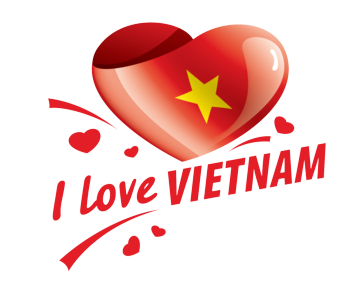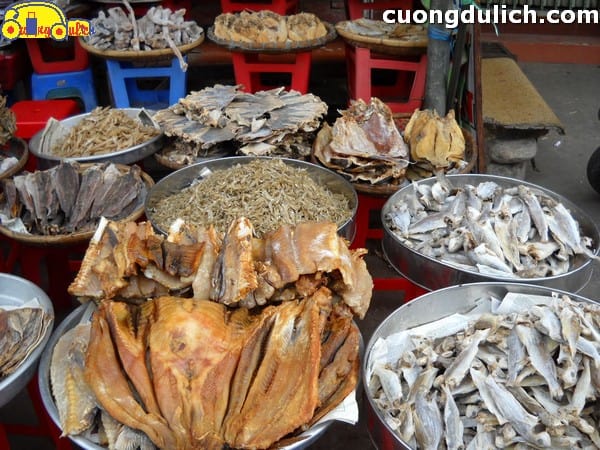Mui Ne is one of the most famous tourist destinations in Phan Thiet in 2019 with beautiful landscapes, pristine beaches, and especially unique cuisine. If you have the opportunity to travel to Phan Thiet, visit Mui Ne, you must visit the Mui Ne seafood market – known as the paradise of delicious, affordable seafood.
However, the question is how to shop at the Mui Ne seafood market in the most standard way, Cuong Travel will share with you the experience of shopping at the Mui Ne seafood market without being ripped off so you can enjoy all the unique delicious dishes here and buy seafood as gifts without being cheated.
1.Learn about the Mui Ne seafood market
Where is the Mui Ne seafood market?
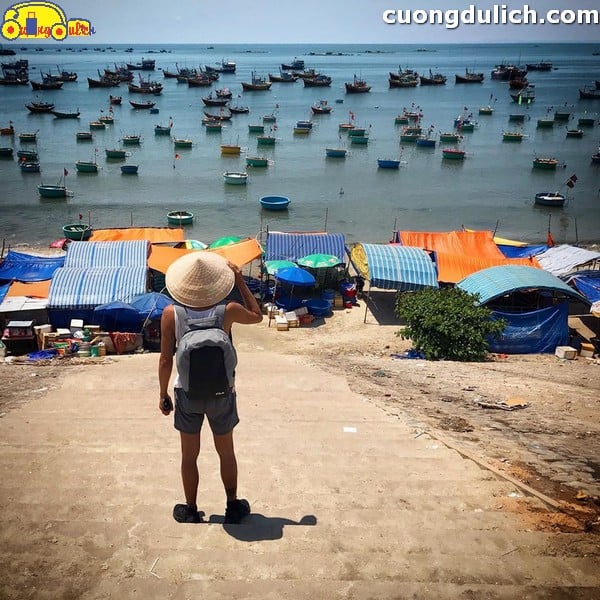
You may have heard of Mui Ne fishing village, but the information Cuong is about to share will surely make you interested in this coastal village. Considered a miniature image of the peaceful Binh Thuan sea, Mui Ne fishing village is not only peaceful and charming with unique natural landscapes, but also contains many lively rhythms of coastal life. If in the morning this place is quiet with hundreds of boats seemingly asleep under a sky full of magical blue, then when dusk falls, Mui Ne fishing village adorns itself with the shimmering silver sea color, and each anchored boat is a simple, rustic feature. This is also the place where masterpieces of natural photography about coastal life are born.
You may wonder why Cuong mentions Mui Ne fishing village when talking about the location of the Mui Ne seafood market, because the reason is that the Mui Ne Seafood Market belongs to Mui Ne fishing village, this Phan Thiet tourist spot is located at 321 Huynh Thuc Khang, Mui Ne, Phan Thiet City, Binh Thuan. Therefore, in any Phan Thiet tour, visiting Mui Ne will always combine visits to these two famous Phan Thiet tourist spots, convenient for travel and experiencing both famous Phan Thiet tourist spots, what could be better, right?
What does the Mui Ne Seafood Market have?
If you are on a 2-day 1-night Phan Thiet tour, then spend a morning visiting the Mui Ne seafood market. When you arrive at the Mui Ne seafood market in the early morning at sunrise, you will feel the vibrant yet peaceful life at this famous Phan Thiet tourist spot.
Starting from Mui Ne fishing village, when the sun rises behind the horizon, the waves begin to gently ripple, the bustling voices of fishermen, the sound of boats preparing to sail… Everything appears like the most vivid and realistic oil painting of Mui Ne fishing village. Stepping down a fairly long three-step ladder, you will enter the fish market area, where local people cast their nets every early morning, and where they buy seafood such as squid, shrimp, fish… from the newly returned fishing boats. This fishing village mainly serves the local population’s needs, where women negotiate prices, buy and sell whenever a new fishing boat returns from the sea. Besides, there are live seafood tanks for tourists visiting Phan Thiet who want to buy for self-cooking or enjoy on the spot. Each small boat that arrives pours all the effort of catching onto a small canvas spread on the sand, from here they will sort out squid, fish by species, different sizes and then retail to tourists or locals in need. Fresh cheap squid, cheap fish are quickly bought and exchanged. Depending on the size, seafood from this Mui Ne seafood market will be taken to seafood farms, restaurants, or retail outside the market.
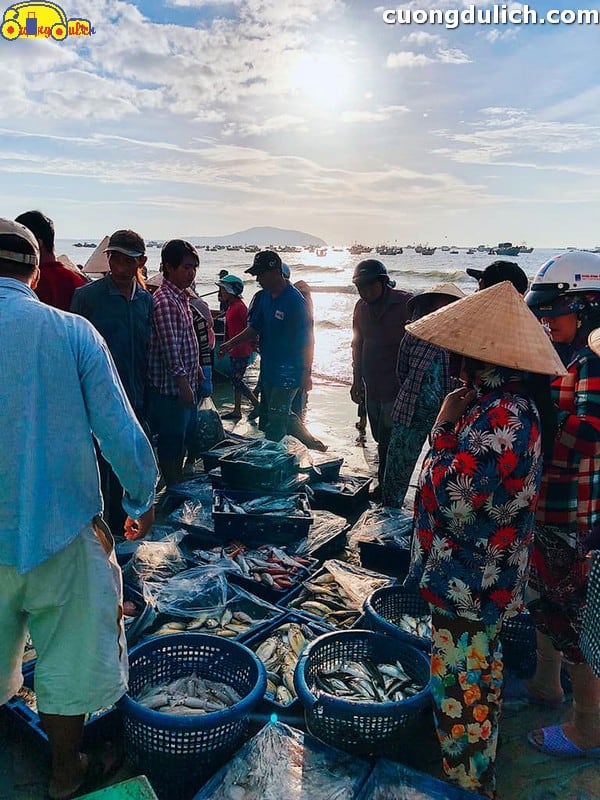
For many years, life at the Mui Ne seafood market has remained calm and simple, just like the nature of the local people here. The freshest seafood in Mui Ne is sold at affordable prices, and you can negotiate before buying. Typically, seafood is caught and immediately sold to customers for them to enjoy the freshest taste. Therefore, when visiting the Mui Ne seafood market, besides admiring and taking photos of the beautiful sea views, you can also buy the freshest seafood at the cheapest prices.
Similar to other seafood markets, the Mui Ne seafood market sells all kinds of seafood, including various types of fish, crabs, squid, and clams. However, the most popular are tuna, clams, and squid. You can buy different sizes at corresponding prices. Due to its proximity to the Mui Ne fishing village, the seafood is always fresh as it is brought from the sea to the market quickly.Another useful piece of information is that when shopping at the Mui Ne seafood market, you can experience the feeling of being with fishermen who catch seafood, then prepare and enjoy delicious dishes right on the beach. It will be a very interesting experience that you should not miss when visiting Phan Thiet tourism. Even more interestingly, after choosing the seafood you like, the sellers will “point” you to nearby restaurants to have your purchases cooked according to your preferences, with prices ranging from 20,000 to 40,000 VND per dish. Usually, during holidays, especially on April 30th in Mui Ne, the fishing village becomes busier, and more seafood is caught, giving you the opportunity to buy even fresher seafood. If you have more time to explore deeper into the fishing village, you will learn how dried fish, dried squid, and fish sauce are meticulously made. You will also be welcomed with fresh, sweet coconuts, just like the warm smiles and hospitable hearts of the people in Mui Ne. Isn’t that wonderful?
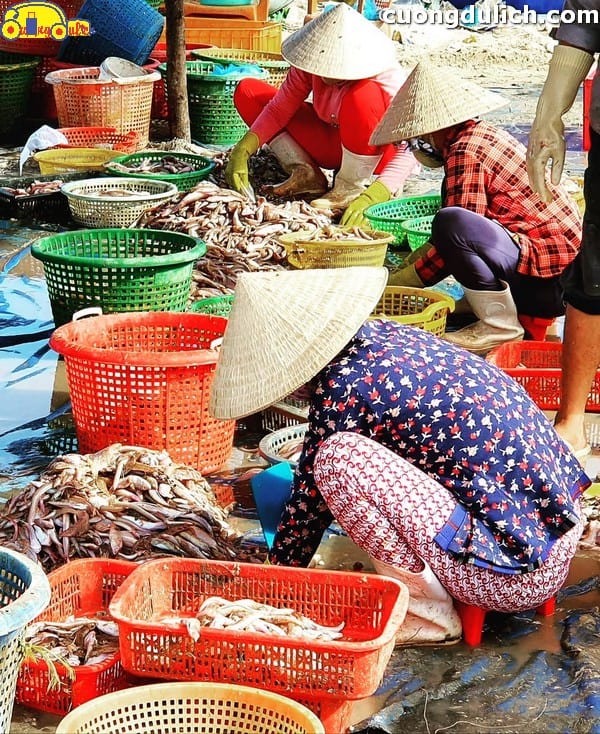
One extremely special thing that Cuong noticed at this Mui Ne seafood market is that they offer a seafood boiling service for only 10k per time. Fresh and delicious seafood is boiled and served with various spices, making it incredibly tasty and aromatic. Remember to try it, as it will surely be an unforgettable experience.
In addition to the live seafood, the Mui Ne seafood market is also famous for its dried seafood such as dried squid, dried fish, dried shrimp, displayed in abundance at various stalls. The most popular item is still the dried squid. These carefully packaged dried squids are hygienic and well-prepared, making them a great gift option. Therefore, you can be completely assured when buying them as gifts. Typically, in Mui Ne tours, visitors from afar often visit the Mui Ne seafood market to buy dried squid as gifts. So, if you visit the location Phan Thiet tourism don’t forget to bring back a few kilograms of dried seafood as a gift that is both high-quality and guaranteed for your loved ones.
Mui Ne seafood market charges for seafood by the bucket
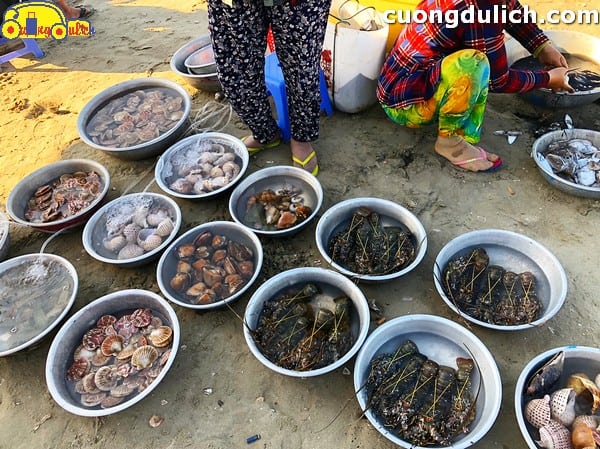
The most interesting thing Cuong found at the Mui Ne seafood market is that the seafood is packed in basins, sold at a fixed price of 100,000 dong per basin. Tourists in Phan Thiet can choose the size and quantity of seafood they want comfortably. Lobsters are also sold at a fixed price of one million dong per basin containing 4-5 lobsters, each weighing about half a kilogram.
When Cuong visited the Phan Thiet Mui Ne seafood market, he met Nam Phuong, a female tourist from Ho Chi Minh City. Cuong asked Nam Phuong about her impressions of Mui Ne seafood, and she said: “The seafood here is fresh and much cheaper compared to markets or some stores. At first, I was a bit surprised because they don’t weigh the items but sell them by the basin. I haven’t seen this kind of selling anywhere else, going to the market is both strange and fun.”
According to local residents sharing with Cuong, this estimated trading style has been a long-standing tradition of coastal people. When tourists visit and want to buy seafood for cooking, “I used to buy and sell in bulk, from tens to hundreds of kilograms each time, now people buy 1 – 2 kilograms and need a scale. For a while, some people had scales, but when they were not accurate, they switched to selling by the basin, fixed price, whoever wants to buy what can choose, no more cheating or inaccurate weighing,” Ms. Vu, who has been trading at the Mui Ne seafood market for over ten years, said. In addition to the basins of seafood priced at 100,000 dong each, a few small traders still sell by the kilogram for tourists with specific needs. The Mui Ne seafood market mainly sells expensive seafood such as abalone, large squid, live lobsters… According to local residents, the seafood in the fishing village is famous for being cheap and fresh, but if you buy carefully, you need to pay attention. “It’s best to bring a half-liter bottle of water, place it on the scale to see how much is missing or needed before buying, negotiate for a fair price,” the owner of a homestay in Mui Ne said.
Read more: Phan Thiet Travel and Unmissable Destinations
2. Some Tips for Buying Seafood at Mui Ne Seafood Market in Phan Thiet
Playing the role of a wholesale seafood market, the prices at the Mui Ne seafood market are relatively cheap. If you visit the Mui Ne seafood market in the early morning, you have a better chance of buying fresh and cheaper seafood. As a spontaneous market of seafarers, the Mui Ne seafood market is becoming more crowded and a favorite Phan Thiet tourist spot for its fresh and diverse seafood. Specialties from the Phan Thiet coastal area such as tuna, barramundi, crab, abalone, mantis shrimp, squid, razor clam… are almost always available at this market. Seafood that has just been caught, still fresh and not frozen, is very attractive to many people, especially housewives and distant guests. Although the Mui Ne seafood market is famous, it still has some shortcomings, so to avoid disappointment when shopping at the Phan Thiet market, you should consider the following tips from Cuong:
Ideal Time to Buy Fresh Seafood at Mui Ne Seafood Market
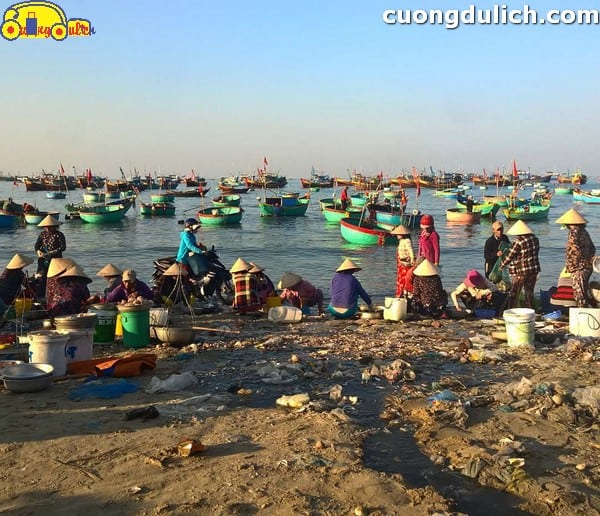
Starting from 5:30 to 6 am onwards, the boats and coracles offshore take turns bringing a large source of seafood to the shore. Strong men jump down to pull the boats and coracles, unload everything caught during the night, and spread them on a tarp on the sand. The Mui Ne fishing village mainly serves the local needs, but there are also many tourists who come to buy or process and enjoy seafood on the spot. Therefore, if you want to buy the freshest seafood at the Mui Ne seafood market, you should go to the market areas early, before 7 am, to choose and buy the best seafood when the fishermen have just returned from their catch. If possible, you should invite other customers to buy together to get wholesale prices, which will be cheaper.
How to choose fresh seafood and avoid being deceived with spoiled goods
Talking about Mui Ne without mentioning seafood would be a big mistake. As a coastal area, Mui Ne has a variety of delicious seafood: fish, shrimp, squid, crab, various types of snails, clams, etc. Each type has its own delicious taste. The seafood in Mui Ne is very fresh. The crabs are big, firm, and full of meat, not soft. There are various types of shrimp: green-legged shrimp, lobster, mantis shrimp, slipper lobster, etc. The live shrimp jump around in the nets. When you visit the Mui Ne seafood market in the morning, you will witness the bustling scene of a new day. However, not everyone knows how to choose the freshest seafood, so below Cuong would like to share with you some tips to choose the best quality seafood:
Experience in choosing and buying crabs at the Mui Ne seafood market
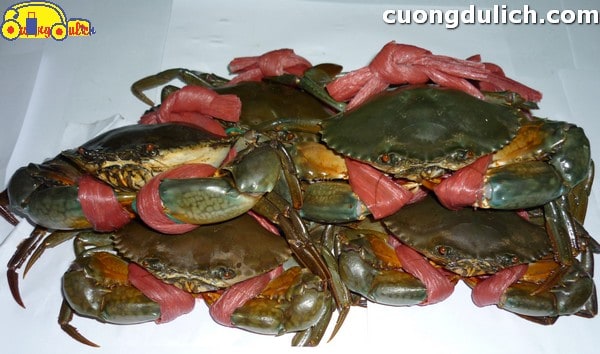
When choosing crabs, look at the grayish opaque shell from the outside, press the crab’s apron with your hand to feel its firmness, a larger apron indicates more meat. Remember to press the apron to get the best feel. Choose fresh and delicious crabs that are still moving their aprons, with legs firmly attached to the body, moving vigorously, flexibly, with sharp spikes on the legs and the crab’s shell still intact.
Not recommended: Do not choose crabs with greenish-looking legs and shell, pressing the apron and feeling it soft indicates a watery, spongy, less meaty, and less tasty crab.
Experience in choosing and buying mantis shrimps at Mui Ne seafood market
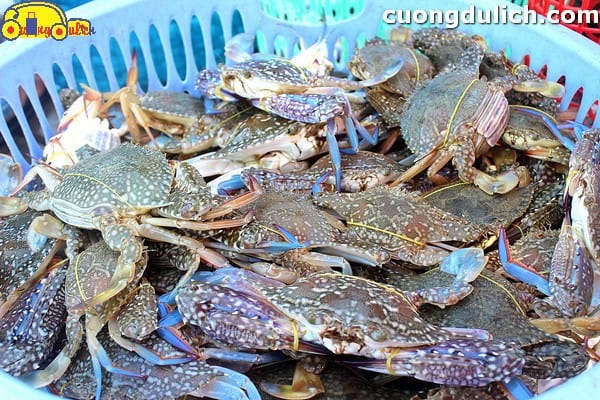
Going to the beach without eating clams is truly a waste of time. The best time to enjoy delicious clams is at the beginning and end of the month when they are fresh, during the period before and after they shed their shells. When buying seafood at the Mui Ne seafood market, you should consider what you want to eat. Currently, at the Mui Ne seafood market, there are many types of clams such as red clams, three-spot clams, green clams… But among them, the most delicious, meaty, and nutritious type is the green clam. After choosing the clams, remember the following:
+ Choose: Select clams that are not too big or too small, ones that feel firm when held and do not have any dents or soft spots when pressed. If you prefer male clams, press near the lower part of the shell near the hinge, if it doesn’t dent, then it’s a firm clam. If you prefer female clams, choose those with a slightly yellowish hue, with legs that are very firm and not soft or dented.
+ Avoid: Clams that are too big, too small, have soft shells, are too large, or are dead.
Tips for buying shrimp at the Mui Ne seafood market:
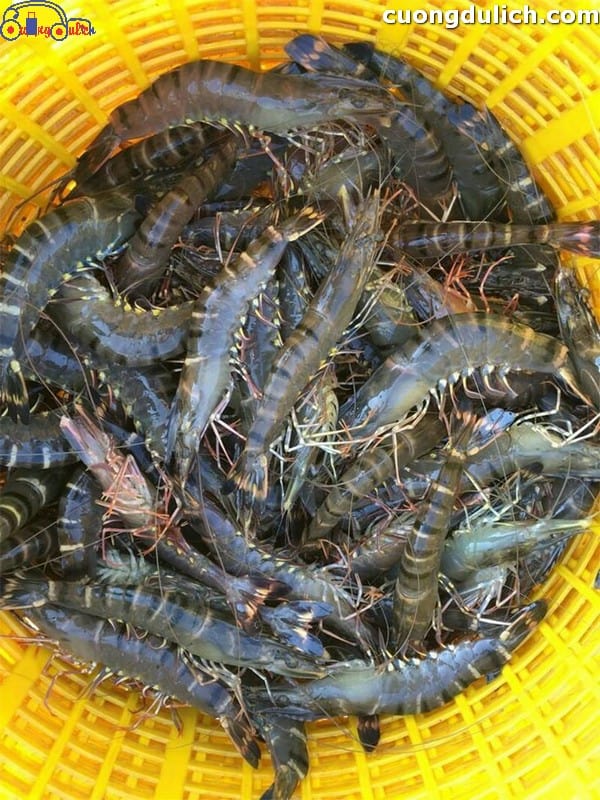
+ Nên chọn: Tôm ngon thân phải săn chắc, vỏ còn cứng, màu trắng trong chứ không đục hay ngả sang đỏ, vàng. Phần đầu dính chặt vào thân, các càng vẫn còn nguyên, không có mùi tanh, ươn.Tôm ngon thân phải săn chắc, vỏ còn cứng, màu trắng trong chứ không đục hay ngả sang đỏ, vàng .
+ Không nên chọn: Không nên mua loại tôm có thịt mềm, màu ngả đục hay các màu khác, chân rụng rời hay không còn vận động bơi lội
Kinh nghiệm mua cá ở chợ hải sản Mũi Né:
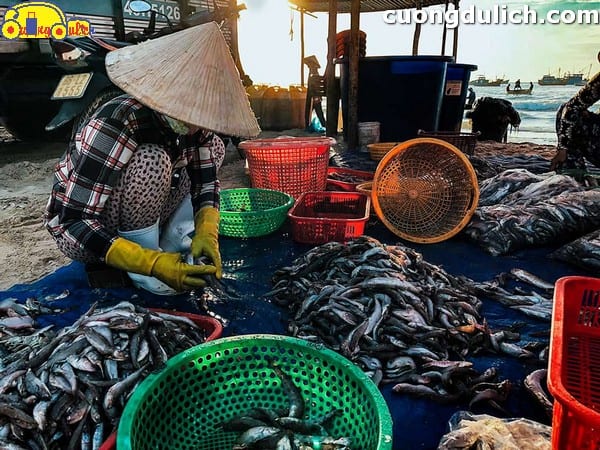
Experience in choosing seafood at Mui Ne seafood market for everyone when buying fish is:
+ Should choose: Fresh fish, still swimming, bright eyes, flexible. If you lightly press on the fish’s body and the flesh springs back to its original state, then it is fresh fish. The nature of fish meat is elasticity. Over time, when the fish is lifted out of the water, this ability will decrease. Fish with red or pink color are fresh and full of vitality. A fresh fish must have scales tightly packed and shiny. The skin should not have any blemishes.
+ Should not choose: Dead fish, fish with bulging eyes, fish with blemishes on the body.
Experience in buying squid at Mui Ne seafood market:
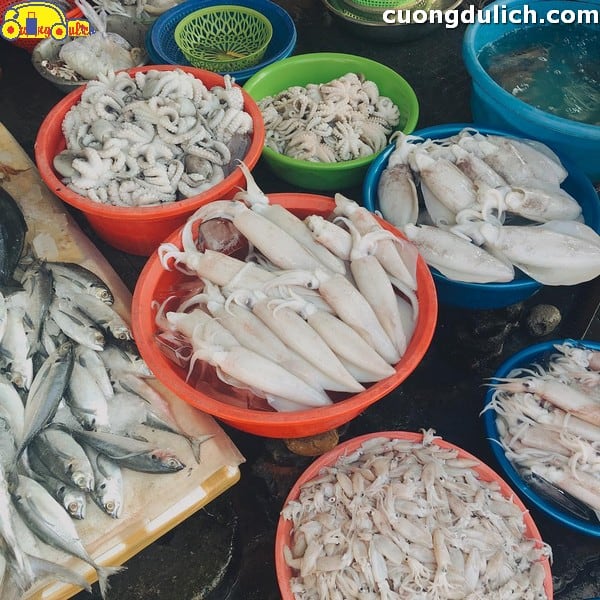
+ Nên chọn: Chọn mực tươi nên chọn con to, dày mình, trắng đục như cùi dừa, thịt chắc không bị nát, lớp màng màu nâu bao quanh đều bên ngoài đối với mực nang còn mực ống thì chọn con có lớp thịt màu sáng hơi hồng, đầu vẫn dính chặt vào thân, túi mực chưa bị vỡ.
+ Không nên chọn: Loại mực màu quá đậm, đầu không dính chặt vào thân, túi mực bị vỡ.
Kinh nghiệm mua sò ở chợ hải sản Mũi Né:
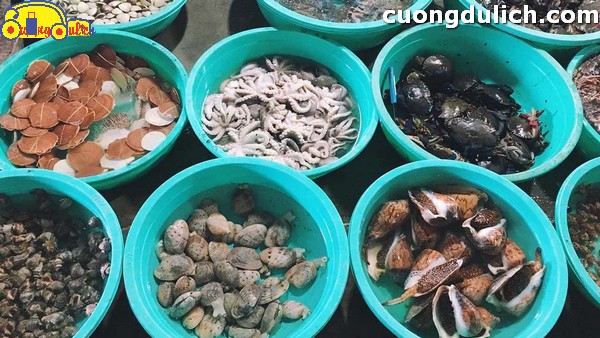
+ Should choose: The way to choose different types of clams is not much different. For delicious blood cockles, you should choose ones that are just the right size to eat because if they are small, they will shrink when boiled, and if they are too big, they can become tough. Fresh clams can be identified when you see many sticking their tongues out in the basket. If the clams are closed, you should smell them; if they have a bad odor, you should not buy them.
+ Should not choose: Clams with inconsistent sizes, bad odor.
Should you buy frozen seafood as a gift?
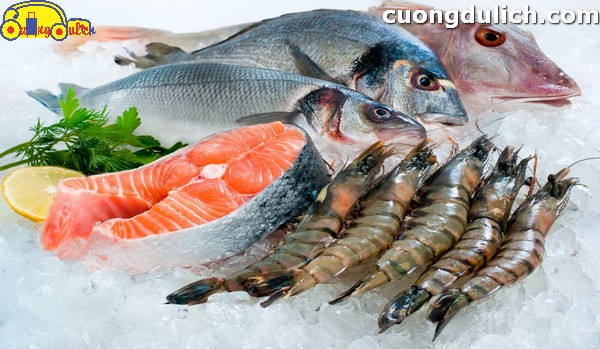
Whoever has traveled to Phan Thiet, especially if you have visited the Mui Ne seafood market and don’t want to buy gifts or seafood to bring back to enjoy slowly or give to your loved ones, why not? Because of the long distance that needs to be transported, many tourists choose to buy frozen seafood to bring back for convenience!!! For example, dried squid, crabs, tuna, mackerel, etc. But this is a mistake and many tourists have experienced it. For example, when buying a squid as big as a hand, but when you get home, it shrinks to just… three fingers… Or buying 3-4 kg of fresh tuna that looks so fresh, but when you get home, the meat is mushy and even smelly, or buying crabs and they all lose their claws…. So how should you buy seafood to ensure it stays fresh when you bring it back?
If you go travel to Phan Thiet and want to buy fresh items, remember to visit the Mui Ne Fishing Village around 7-8 in the morning, when the fishing boats have just docked, you can freely choose fresh items. Remember to only buy seafood from newly arrived boats, and do not buy from seafood stalls here, the reason why Cuong has explained above! One thing to note: When you have chosen the seafood you want to buy, put it on the scale and make sure it’s correct, always pay attention to your basket of seafood until they wrap it in plastic and hand it to you. There have been many cases where you choose a nice piece of fish, put it on the scale, and when you’re distracted, they switch it with a different, inferior piece…
How to preserve seafood and bring it back to the mainland
After enjoying traveling to Phan Thiet, what should you do before returning? The answer is definitely to buy gifts for your loved ones and friends to share a bit of the sea’s flavor, right? One of the gifts that contain the most sea flavor is seafood, but if you don’t know the secret of preserving and packaging fresh seafood, the seafood you bring back will no longer be fresh. So Cuong will share with you 3 secrets to bring back fresh seafood:
Secret 1: To preserve for a long time, choose fresh seafood
The experience of keeping seafood fresh for the longest time when bringing it back as a gift for friends and family, Cuong wants to share with you is to choose the best fresh seafood possible because no matter how good the transportation process is, it will still reduce the quality of the seafood. The fresher the seafood, the easier it is to preserve and the longer it will last. As for how to choose the freshest seafood, you can refer back to the section on how to choose fresh seafood that Cuong mentioned above.
Also, keep in mind that the time of purchase affects the quality of the seafood. For example, on overcast days, squid fishing is usually not effective, so almost all fishing boats do not go squid fishing during this time, so the squid during this period is not the freshest. Similarly, on full moon days, it is best to avoid buying cuttlefish, crabs, or mantis shrimp because these seafood items are not fresh and tasty.
Secret 2: Each type of seafood has its own packaging method
- Shrimp, crabs, fish, and mantis shrimp, if packaged correctly, will extend the transportation time, helping the seafood stay fresh longer.
- Crabs are easy to package, so they don’t need much preservation. If you want to transport crabs far away in large quantities, you just need to buy a foam box, remember to poke holes for the crabs to breathe, then cover with a damp cloth to maintain moisture for the crabs and seal the box. If you buy a small quantity, around 5 crabs, ask the seller to tie them together for easy carrying, then put them in a plastic bag, sprinkle some water, occasionally splash water on the crabs, and avoid direct sunlight.
- Other seafood items like shrimp, mantis shrimp, squid, clams, mussels, and various types of snails have a short survival time after being isolated from water, so they must be packaged by marinating with ice. Use a foam box to retain heat for a long time without leaking water, sprinkle a layer of crushed ice, then place a layer of seafood until the box is full. If you want to be more hygienic, ask the seller to vacuum seal before marinating with ice. Remember that the final layer must also be ice. Then close the lid and tape the box tightly. If you are extra careful, wrap a layer of plastic outside the foam box.
- For live lobsters, you must package them by asking the seafood vendor to give them a sudden heat shock to put the lobsters into a dormant state, meaning suddenly putting the lobsters into the appropriate coldness, then put them in a nylon bag, tie tightly, and place them in a foam box. When packing, remember to ask for a few large seaweed pieces that have been soaked in water in case you don’t want to process the lobsters immediately upon arrival and want to preserve them longer.
Secret 3: Pay attention to the preservation time of each type of seafood
Just like packaging, each type of seafood has a specific time frame, and if exceeded, the seafood will become thin, the meat will become mushy, and it will no longer be fresh and tasty. Therefore, Cuong advises you on the time you can keep each type of seafood at its freshest. Mantis shrimp should be processed within 3 days, it’s best to process it immediately because mantis shrimp are difficult to keep without losing meat. Crabs should not be kept for more than a week and must be kept alive by placing them in a cool place, occasionally splashing water on them to keep them moist. Lobsters need seawater to live, if not, they cannot survive long. In the conditions where you keep lobsters in a foam box and cover them with wet seaweed, lobsters can survive for 3 days. Clams, mussels, and snails that are not processed immediately can be preserved for 24 hours if kept in the refrigerator, and if frozen, they can be kept for about 2 weeks.
3. Tips for tourists to avoid being overcharged when visiting the Mui Ne Seafood Market
Negotiating prices when buying items
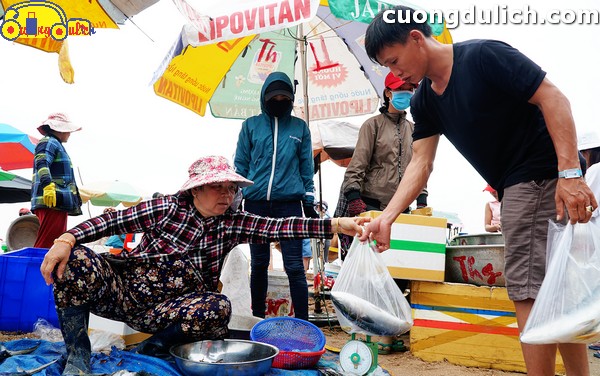
For tourists traveling to Phan Thiet from afar, Cuong’s experience in buying seafood at Phan Thiet market advises you to negotiate the price before purchasing any seafood because if you don’t know how to negotiate, you might end up overpaying for the items. Many stalls advertise “cheap seafood” but in reality, the prices are not cheap at all. If you buy solely based on seeing a low price without asking or negotiating, you will likely fall into the trap set by those seafood vendors. Many people have had to pay 1.2 million VND for 1kg of live razor clams, while in other places they are sold for only 120,000 VND/kg. A local expert here shared a tip with Cuong when shopping at Mui Ne seafood market, suggesting to negotiate the price down to 50% because sellers often “inflate” prices. For example, when buying dried squid priced at 800k, buyers should negotiate down to around 400 – 500k. Additionally, it’s recommended not to buy from just one shop, but to survey a few shops to compare prices before making a purchase. Moreover, if you have acquaintances in Mui Ne, you can seek their advice before buying for added peace of mind.
Carefully check the seller’s scale
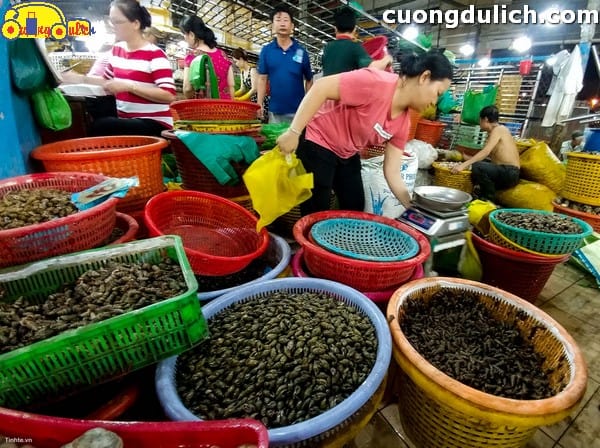
When you have chosen your seafood, of course, the seller must weigh it for you before calculating the price, right? However, here lies the issue. Specifically, when you weigh the clams on the scale, it shows 2 kg, but when you get home and weigh it again, it’s only about 1 kg. That’s why many customers mistakenly think they are buying 2 kg of clams at a much cheaper price than at the market, but in reality, they don’t know that the scale has been adjusted… With Cuong’s experience in shopping for seafood in Mui Ne, he advises you to make an accurate estimate before weighing. There have been many cases reported about underweight scales at the Mui Ne seafood market, but nowadays, due to various regulations, this situation has improved compared to before. However, we should still be cautious and check the goods before leaving the counter.
After paying, make sure to check the goods before leaving the counter.
Another tip when buying seafood at the Mui Ne seafood market is to pay attention to the seller when weighing the goods, as there are cases where sellers swap the seafood when the buyer is not paying attention. Once you have chosen the seafood you want to buy, place it on the scale, and when it’s okay, always keep an eye on your basket of seafood until they wrap it in plastic and hand it to you. There have been many cases where customers selected a good piece of fish, placed it on the scale, and then paid without noticing that it was swapped for a different, inferior piece. Cuong has encountered some restaurants in the fishing village that engage in dishonest practices, swapping customers’ goods. So, if you buy seafood from the fishing village and then take it to a restaurant for preparation, especially lobster, it’s advisable to break off one of its claws as a mark, so the restaurant cannot swap a dead lobster for yours.
Remember to carefully select fresh live products.

If you want to eat fresh and delicious seafood that guarantees quality, then you must know how to choose fresh live seafood, right? Because if you don’t know, you may be easily deceived by sellers into buying seafood that is already dead or no longer fresh. Previously, some Chinese tourists visited Phan Thiet for tourism, went to Mui Ne seafood market to buy seafood, especially lobster, because they didn’t know and were tempted by cheap prices, so they ended up buying all dead lobsters, and after cooking, they praised the taste because they thought Vietnamese lobster meat was like that, not knowing it was dead. So remember to carefully grasp the experience of choosing fresh and delicious seafood that Cuong has shared above.
Save the hotline number in Mui Ne
Most of the time, when tourists are “ripped off” during their travels, they either swallow their anger or vent on social media. The psychology of most tourists is to avoid conflict and arguments in unfamiliar places. This has allowed some businesses to take advantage and overcharge customers. Therefore, if unfortunately you are “ripped off” when using tourism services in Mui Ne (Phan Thiet, Binh Thuan), tourists can contact the numbers 0623.810.801 and 0623.608.222 in case of needing assistance. Authorized units will send someone to help tourists resolve difficulties. Additionally, tourists can contact those phone numbers to ask for directions, tourist spots, or any travel-related information about Mui Ne.
4. What to buy as gifts at Mui Ne seafood market
Travelers visiting Phan Thiet should stop by the Mui Ne seafood market for a wide selection of gifts to take home. In addition to fresh and nutritious seafood, dried seafood is one of the unique specialties of Mui Ne that everyone wants to bring back as a gift. Dried seafood is very convenient for travelers to purchase after their trip to Phan Thiet, and buying dried seafood directly in Mui Ne is very reasonably priced, not too expensive.
You may wonder why fishermen often make dried seafood. According to Cuong, the people of Mui Ne, and coastal residents in general, have many reasons for making dried seafood. One reason is the large quantity of seafood caught by fishermen that cannot all be consumed fresh. Therefore, fishermen dry the seafood to preserve it for longer periods.Another reason is that dried seafood has a very unique flavor. Sometimes, to change the taste of normal fresh seafood, people in Mui Ne prefer to eat dried seafood for its fragrant and chewy taste.Another reason, which the coastal residents will understand, is that dried seafood is a “life-saving” food for coastal residents during heavy rainstorms. On rainy stormy days when no restaurants are open, people have to rely on dried seafood, which most coastal residents have in stock. In the cold weather, with a bowl of hot rice and prepared dried seafood, suddenly everyone feels happy. From dried squid, dried fish, to dried shrimp… travelers can prepare various delicious dishes. The people of Mui Ne often use dried seafood to make grilled dishes, braised dishes with tomato sauce, or salads with dried seafood… It sounds tempting, right? So why hesitate to visit Phan Thiet, stop by the Mui Ne seafood market, and bring back some dried seafood as gifts?
It is often said that markets reflect the cultural characteristics of a region, and to understand more about customs, traditions, and unique culinary features of a region, there is no better place than the market. The Mui Ne seafood market is no exception; it is not only a place for livelihood in daily life but also partly reflects the unique culinary traits of coastal residents. If you have visited Phan Thiet, do not miss this Mui Ne seafood market area. Hopefully, the information provided by Cuong will help you have the most convenient and enjoyable trip to Phan Thiet, along with choosing the best seafood at this Mui Ne seafood market. Don’t forget to like and support Cuong’s travel channel to stay updated on all useful travel information in Cuong’s upcoming articles.
